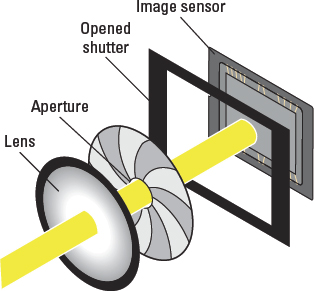Introducing the Exposure Trio: Aperture, Shutter Speed, and ISO
Any photograph, whether taken with a film or digital camera, is created by focusing light through a lens onto a light-sensitive recording medium. In a film camera, the film negative serves as that medium; in a digital camera, it's the image sensor, which is an array of light-responsive computer chips.
Between the lens and the sensor are two barriers — the aperture and shutter — which work in concert to control how much light makes its way to the sensor of a digital camera. The actual design and arrangement of the aperture, shutter, and sensor vary depending on the camera, but Figure 7-1 offers an illustration of the basic concept.

Figure 7-1: Aperture size and shutter speed determine how much light strikes the image sensor.
The aperture and shutter, along with a third feature — ISO — determine exposure, which is basically the picture's overall brightness and contrast. This three-part exposure formula works as follows:
- Aperture (controls amount of light): The aperture is an adjustable hole in a diaphragm inside the lens. You change the aperture size to control the size of the light beam that can enter the camera.
Aperture settings are stated as f-stop numbers, or simply f-stops, and are expressed with the letter f followed by a number: f/2, f/5.6, f/16, and so on. The lower the f-stop number, the larger the aperture, ...
Get Nikon D600 For Dummies now with the O’Reilly learning platform.
O’Reilly members experience books, live events, courses curated by job role, and more from O’Reilly and nearly 200 top publishers.

